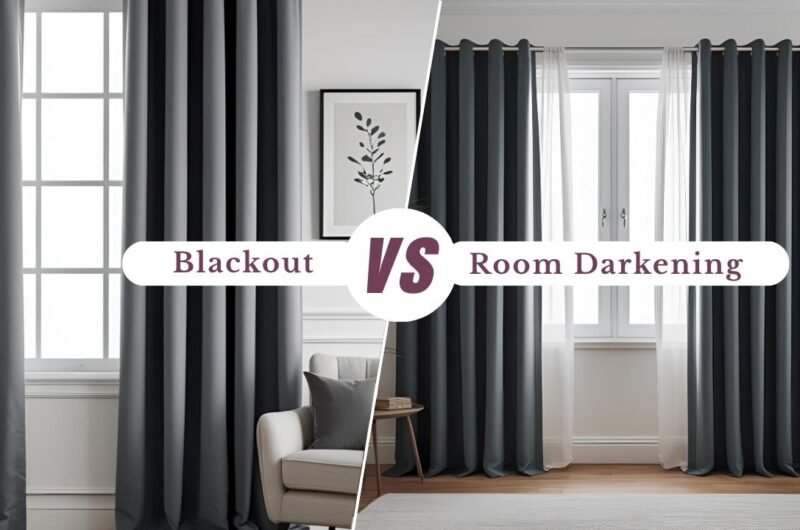When it comes to creating a comfortable and peaceful home environment, the right window treatments can make a big difference. One of the most common questions people ask is: What is the difference between blackout curtains and room darkening curtains? Today, we will help you understand exactly what sets them apart, so you can choose the best option for your needs. Whether you are a light sleeper, a shift worker, or just looking for better privacy and energy efficiency, this guide will give you clear, trustworthy information to make an informed decision.
Blackout curtains and room darkening curtains are two popular types of light-blocking window treatments. While they may look similar and serve overlapping purposes, they are not the same. Understanding the differences in light control, fabric, functionality, and real-world benefits will help you pick the right solution for your bedroom, nursery, media room, or any space where light and comfort matter.
What Are Blackout Curtains?

Blackout curtains are designed to block nearly all incoming light. According to the Sleep Foundation, these curtains can reduce light by 99% to 100%, making them ideal for people who need complete darkness to sleep well. They are made from tightly woven fabrics such as polyester or microfiber, often with a special backing layer that enhances their light-blocking power. Some high-end models use a triple weave technology, which increases density without adding excessive weight.
These curtains are commonly used in bedrooms, nurseries, and home theaters. They are especially helpful for shift workers who sleep during the day and for children who benefit from a consistent sleep environment. A study published by the National Sleep Foundation found that reducing ambient light during sleep can improve sleep quality by up to 30% in light-sensitive individuals.
In addition to blocking light, blackout curtains offer several other benefits. They provide excellent thermal insulation, helping to keep rooms warmer in winter and cooler in summer. This can lead to energy savings over time. According to the U.S. Department of Energy, properly installed window treatments like blackout curtains can reduce heat loss by up to 25%, making them a smart choice for energy-saving curtains.
Many popular brands like IKEA, Amazon Basics, and Home Depot, along with trusted local suppliers like BlackoutCurtains, offer affordable and stylish blackout curtain options, including grommet and rod pocket styles. These products are often made from durable materials like polyester and are easy to install in most homes.
What Are Room Darkening Curtains?

Room darkening curtains are a step below blackout curtains regarding light control. They typically block around 90% of incoming light, allowing a small amount of soft glow to filter through. This creates a dim, relaxing atmosphere without making the room feel completely sealed off. They are made from thick, dense fabrics such as cotton, velvet, or microfiber, but they usually do not have the same coated backing as blackout curtains.
These curtains are a great choice for people who want to reduce glare and brightness but still enjoy some natural light during the day. They work well in living rooms, guest rooms, and nurseries where total darkness is unnecessary. For example, parents may prefer room darkening window treatments in a baby’s room to support healthy sleep cycles while still allowing gentle morning light to help regulate the child’s internal clock.
Room darkening curtains also contribute to improved privacy and moderate thermal insulation. While they are not as effective as blackout curtains in blocking heat or noise, they still offer noticeable improvements over standard curtains. Their softer drape and more decorative appearance make them a popular choice for those who want functional window treatments that also enhance the look of a room.
Key Differences Between Blackout and Room Darkening Curtains
The biggest difference between blackout and room darkening curtains is the level of light blocked. Blackout curtains provide near-total darkness, while room darkening curtains create a softly lit environment. This difference in curtain opacity affects how each type performs in real-life situations.
For example, if you are a light sleeper or work night shifts, blackout curtains may be the better choice. They are often recommended by sleep experts as part of a sleep-enhancing curtain system. On the other hand, if you like to wake up naturally with the sunrise or want a cozier, less enclosed feeling, room darkening curtains might be more suitable.
Another important factor is fabric layers. Blackout curtains usually have multiple layers, including a foam or acrylic coating that blocks both light and UV rays. This makes them more effective at protecting furniture and flooring from sun damage. Room darkening curtains rely more on fabric density than added coatings, which means they may not offer the same level of UV protection.
When it comes to energy efficiency, both types help, but blackout curtains generally perform better due to their thicker construction and superior thermal insulation. This makes them a top pick for energy-saving curtains in climates with extreme temperatures.
Who Should Use Which Type?
Your personal needs will determine which curtain is right for you. If you are looking for the best curtains for sleeping and need a completely dark room, blackout curtains are the clear winner. They are widely used in hotel rooms and nurseries for this very reason. Our premium quality blackout curtains are known for their affordability and effectiveness, making them a trusted choice for many households.
If you want a balance between light control and a natural feel, room darkening curtains are a great middle ground. They are ideal for living areas or bedrooms where you want privacy and reduced glare but not total darkness. They also tend to be more breathable and easier to wash than blackout styles.
For families with young children, room darkening and light filtering curtains can be a thoughtful choice. It allows kids to nap in a calm environment while still being exposed to natural light patterns that support healthy development.
Read Also: Sheer Curtains vs Linen Curtains: Which Is the Best Choice
Do Blackout Curtains Really Work?
Yes, blackout curtains do work, and there is data to back it up. Independent tests show that high-quality blackout curtains can block 99% or more of light when properly installed. The key is to choose curtains with a tight weave and full coverage. Gaps around the edges can let in light, so consider using curtain rods that extend beyond the window frame or adding side tracks for a complete seal.
Summary
Choosing between blackout curtains and room darkening curtains comes down to your lifestyle and what you want from your space. Both are excellent home privacy solutions and offer benefits like improved sleep, energy savings, and UV protection.
- If you need complete darkness, go for blackout curtains.
- If you prefer a softly lit, cozy atmosphere, choose room darkening curtains.
By understanding the real difference between these two types of window treatments, you can make a confident choice that supports better sleep, privacy, and overall well-being in your home.




